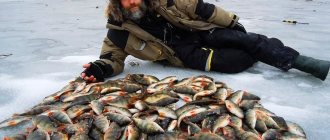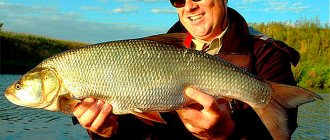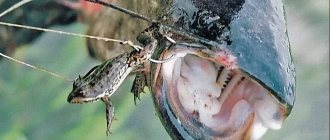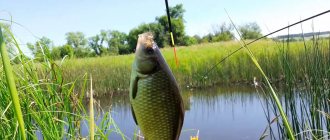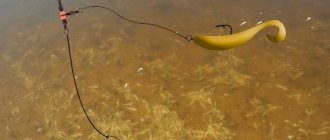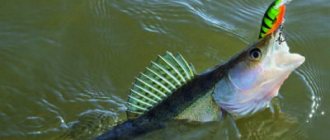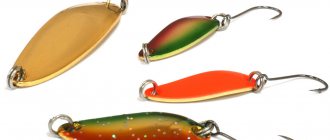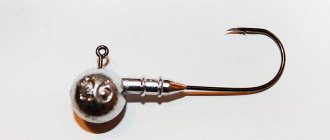Equipping winter fishing rods for pike perch requires some features and nuances, the implementation of which will not give the fanged fish a chance to bypass the bait or make an empty grab. The winter behavior of this predator, tactics and search leave an imprint on the necessary elements of the installation of gear. In this article we will analyze the most popular and working gear for pike perch in winter, equipment options, and features of their use in various conditions.
Winter fishing for pike perch
Before you begin installing fishing rods for winter fishing for pike perch for the first time, it is important to understand that the determining link in the success of hunting for fanged fish is the correct tactics and search for the striped predator in the reservoir. The main thing in winter fishing for this type of fish is to find parking spots or exit points for pike perch. These nuances of predator behavior are discussed in more detail in a special article:
It is a successful search and finding of working points that is the main condition for successful fishing for this fish. In 80% of cases, with successful search activities, even with somewhat incorrect gear, the fisherman is doomed to get bites. Pike perch is greedy and aggressive, periods of complete passivity are rare. In addition to location, the choice of time of day also matters - in some reservoirs, pike perch go out to feed according to a schedule, in others - chaotically and unpredictably. You can also read about all this in the publication at the link given above. Here we will directly analyze the methods of catching pike perch in winter, conventionally assuming that the angler is already familiar with the main points of the correct tactics and search for fanged fish for winter fishing.
Fishing tactics
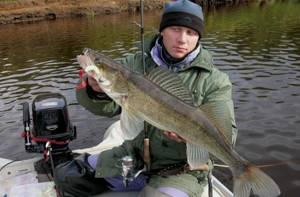
Tactics are chosen based on several factors. We are talking about the season, weather conditions. The productivity of pike perch fishing is influenced by the method itself and the chosen location. They use spinning kits with artificial baits.
Recording the behavior of pike perch at different times of the year
Many people know that the seasonality of hunting for predatory fish has its own characteristics and differences.
Spring
At this time of year, catching a predator is problematic. Activity after winter is low. Individual bursts are observed during the feeding period, immediately before spawning. This is the second ten days of April, until mid-May, which you still need to get to.
In spring, you can hunt fanged animals throughout the day, preferably during daylight hours. The probability of catching a test specimen is twilight. Silicone and/or foam rubber, rotating spoons, and spinners are used as artificial baits. Considering the spring passivity of the predator, especially in cold water, it is better to try catching a fanged one with live bait.
Summer
The water warms up, the predator becomes more active. You can use different tactics and baits. In summer, pike perch is still a little capricious, changing its preferences throughout the day. You can count on a bite throughout the whole day. During periods of extreme heat, fanged fish are also caught at night.
We recommend reading: The most catchy wobblers for asp
In mid-July and August, pike perch often visits the shallows. Activity manifests itself at dawn and/or sunset, when the fanged inhabitant of the reservoir chases small things: bleak, roach. Among artificial baits, the predator reacts to narrow spoons and minnow wobblers.
Autumn
A truly golden time for catching pike perch with a spinning rod. From the beginning of September, pike perch have a feeding frenzy that lasts until freeze-up. This is a good time to experiment with baits. Silicone baits work well - worms, crustaceans, slugs, creatures. You can fish around the clock.
The probability of catching a qualifying and/or trophy specimen is dawn, lunch, and the beginning of sunset. At this time, the pike perch feeds literally by the hour, making only short pauses.
Winter
With the arrival of cold weather, you can fish places with unfrozen water areas: this is the prospect of meeting pike perch. General activity is low; imagination and experimentation are required.
In winter, you can use a Carolina rig or a retractable leash with small baits. When catching pike perch with jigs, foam rubber baits are considered quite perceptive in winter.
Bite and hook
Briefly: the pike perch bite is always powerful and hits the hand. It feels like the predator is pressing down on the bait. You can’t hesitate: instant cutting is necessary. The sting of the hook must be sharp to pierce the bony mouth of the predator. Bringing the fish to the net at an intense pace.
How to catch pike perch
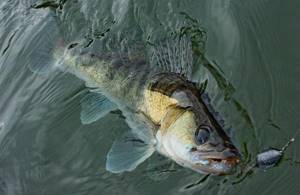
There is no need to injure the fish using a hook. Having pinned a predator in snags among fallen trees, there is no need to rush. You need to try to take him away from the shelter. When working from a boat, it is better to pull up a hooked fish using a forceful style. When hunting from the shore with a long rod, you need to control the prey, preventing it from going into snags.
What gear to use to catch pike perch in winter
Depending on the conditions of the reservoir and the preferences of the fisherman, it is possible to use various winter gear for pike perch. Here are the most popular and working fishing methods:
- Winter sheer glitter,
- Vertical ice jig,
- Fishing with a jig with bait (for example, sprat),
- Winter donks for artificial or natural baits,
- Arrangement of pike perch poles (flags, supplies).
A pike-perch winter fishing rod, regardless of the fishing method, must be strong and elastic, since the striped predator is strong and reaches impressive sizes. Weak tackle simply won’t hold up when biting seasoned pike perch. At the same time, the equipment needs to be sensitive enough to effectively control the bait and register a bite. The best winter fishing rods for pike perch detect the most gentle bite, make it possible to make a sharp hook and do not break when fishing for large prey. Next, we’ll look at how to properly equip a winter fishing rod for pike perch.
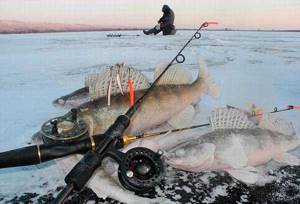
Spring pike perch fishing
In the spring, the water temperature gradually rises, and the pike perch, hungry over the winter, regains its strength, greedily rushing at everything around in a pre-spawning feast. This period is the most successful for the spinning angler, while fans of bottom feeder fishing rarely catch pike perch in the spring.
Pike perch spawn from mid-April to late May , depending on the climate, and this period determines the behavior of the fish in the spring. To spawn, they rush to shallow areas with a rocky bottom, fragments of driftwood with holes and depressions. Unlike other predators, pike perch spawn not as a whole flock, but in pairs, so catching them directly during spawning is not productive.
After spawning, the pike perch is very passive and is practically not caught for approximately 10-15 days. After resting, he again goes to the spawning grounds to hunt and gain strength after the hunger strike. This is the key moment for a spinning player in the spring.
The bite at this time of year is influenced by absolutely everything: weather, day length, atmospheric pressure. It can suddenly appear and immediately stop at any time. Therefore, it is important to check promising areas several times to find feeding pike perch.
Do not ignore places with thickets of aquatic plants and reeds; in the spring, the predator often looks for food in them and reacts to carefully placed bait. Here it is advisable to use a spinnerbait or a small wobbler with non-snacking hooks.
In spring, it is better to use small baits, for example, the weight of jigs should not exceed 25 grams. The rod, as usual, is fast and rigid, 2.5-3 m long, with a fishing line of 0.15-0.2 mm.
Having found a school of pike perch, cast the bait and move the reel and rod with sharp but short movements, teasing the fish that are not fully awake.
However, if the pike perch is attracted by the play of the bait, it will attack quite confidently, with a pronounced bite - you should hook it sharply, since the pike perch’s mouth is very hard and with a weak hook you may not break through the lip. There have already been thousands of cases when hooking occurs, the fish is brought to the shore and it simply releases the bait, since the hooks were not hooked at all, the pike perch simply did not let go of the bait.
Fishing rod equipment
So, to catch pike perch you will need reliable and strong tackle. The equipment for pike perch is not particularly elegant - it makes no sense to use thin fishing lines. A fanged fish at great depths and in the dark (especially since the best time for fishing is night, dusk or dawn) will not be able to distinguish a thick monofilament in the water). Another important factor is the convenience of the gear. The basis of tactics is a constant search for points. In a day you need to drill dozens of holes and fish them. In addition, the fisherman is forced to move a lot. The working hang of the tackle is long, since you always have to fish at fairly large depths, usually from 5 to 15 meters (usually 7-12). Therefore, the fishing rod should be easily retracted for transition and quickly brought into working condition.
Rod
The choice of a rod for winter tackle for pike perch must be approached with all responsibility. Catching many other types of fish does not require high performance characteristics of a winter whip - it is only involved in guiding and partly in hooking. The pike perch has a very strong bony mouth. To cut through it, a strong and elastic hook is required. A weak whip will simply break; too hard a whip will break the fishing rod rig due to lack of elasticity. The bite of a large pike perch sometimes happens sharply and unexpectedly, from acceleration. The tackle must remain stable. A fishing rod is not required only when fishing with hooks - there the hooking is carried out by the fishing line.
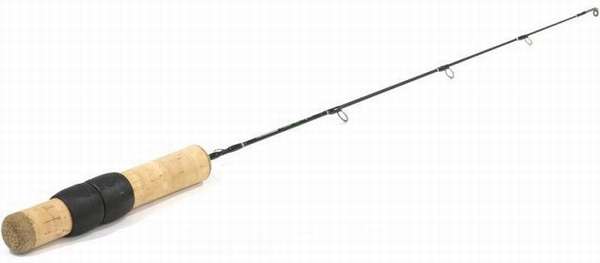
A good option is a special fishing rod for winter trolling. Such carbon fiber winter fishing rods for pike perch (and pike) are obviously made taking into account all the features of fishing. Fiberglass rods are also suitable, they are heavier and cheaper, but it is less convenient to work with them for a long time.
Many anglers make their own equipment for winter fishing for pike perch. As you already understand, the main thing in such a fishing rod is the whip and the rings. The handle and reel seat can be made in any design; a simple wooden stick and electrical tape will do. The main thing is the whip. The whip is purchased at the store. An elastic feeder quivertip or the upper part of a summer spinning rod will also work. Of course, in extreme cases, if there is no opportunity to make or buy good tackle, you can get by with the simplest option - a rough fishing rod with reels. It is inconvenient to work with such gear during active search. Imagine for yourself - every time you go, reel out 10 meters of fishing line onto the fishing rod reel, and then unwind it back. And so dozens (hundreds) of times.
The caliber of the rod depends on the fishing method and the weight of the bait. An experienced fisherman always has a whole set of tackle in his box, pre-configured and matched to the weight of the spoon or balancer. The requirements for fishing rods for winter baits and jigs are the same. Jigs for pike perch are large and heavy, especially for currents.

fishing line
The best fishing line for winter walleye fishing is a good fluorocarbon or fluorocarbon line. Line requirements:
- Diameter 0.25-0.35 mm, depending on the caliber of the tackle.
- Lack of memory.
- Resistant to abrasion and ice damage.
- Low elongation - do not forget about powerful, high-quality hooking.
An excessively soft fishing line at great depths will not allow it to penetrate the mouth of a predator due to its stretchability. Braid and lines are rarely used for pike perch in winter; in the cold they become tanned and stick to the reel. The best solution is high-quality winter fluorocarbon monofilament. Leashes are not used for pike perch; the bait is attached directly to the fishing line with a knot, loop or through a fastener.
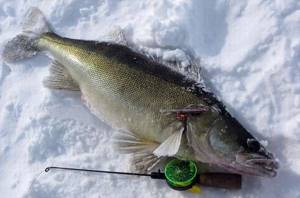
Nod
There are many varieties of nods for winter fishing rods for pike perch; each angler uses something different. You need to understand that the fanged one, especially in winter, prefers low-amplitude, smooth play with long pauses. Therefore, the gear guard should not perform parasitic spring vibrations. The fall of the bait must be smoothly extinguished at the lowest point so that it does not bounce, but slowly fades in its downward movement. Previously, metal spring nods or lavsan, plastic strips from PET bottles were used on fishing rods. Now the best option is to use a frost-resistant silicone tube. Such a nod does not dull in the cold. Silicone nods can be found at a fishing store. If you have the required length of tube, such a nod for pike perch can be done with your own hands in a couple of minutes.
What to catch pike perch in winter
Despite its aggressiveness, the fanged fish cannot compete with pike and feed on large fish. Although the striped one has a huge toothy mouth, its throat is narrow. Pike perch prefers to hunt for relatively small, narrow-bodied fish. Gudgeon, loach, goby, bleak, verkhovka, minnow, dace, sprat are the basis of the diet (depending on the reservoir). Accordingly, when fishing with live bait or girders, as well as as dead fish, it is better to use these breeds.
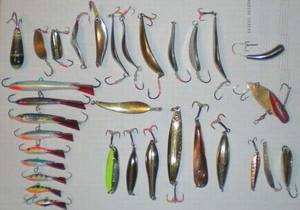
Among artificial baits, fishing for pike perch in winter using spoons, balancers, amphipods and rattlins stands out. Interesting solutions such as voucher (column), bulldozer, and mormobles are successfully used. No one has canceled special heavy pike-perch jigs for replanting sprat or pieces of fish. Read more about winter pike perch baits. A small number of anglers successfully catch pike perch in winter using edible rubber and silicone using a vertical jig. The baits used are vibrotails, twisters, slugs on a jig head, a Cheburashka sinker or a lead rig. Pike-perch does not cut the line on the tackle like pike, so a leash is not used. Lures, depending on the equipment, are attached directly to the fishing line.
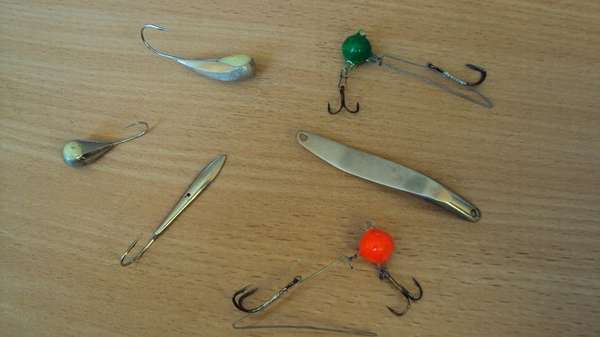
Reels
Ideally, a winter fishing rod for pike perch is equipped with a reel. Fishing is done at depth, the fisherman needs to constantly move, which means he often winds and unwinds the tackle. A reel for winter fishing for pike perch is essential. You can use the following options:
- Cheap plastic ice fishing reels with an open spool. You should choose open reels with a diameter of 50 mm, preferably with a release button. In general, it’s great if such a simple design has a friction clutch.
- Good winter reels for trolling. Such solutions are already more expensive, but this is exactly what is needed. Such devices are specially adapted for winter sheer trolling: there is a friction brake (which allows you to use thinner fishing lines and use American-style fishing with a rod), the drum is large and does not freeze when wet.
- Small spinning reels or multipliers. Very comfortable too. But due to their high cost, they are not very popular.

Where to look for pike perch in open water
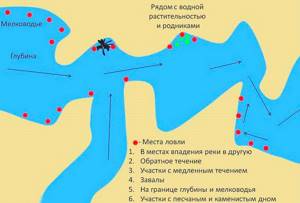
Without knowing the habitats of pike perch in a pond, there is nothing to do. You will be like a blind kitten, poking your face into the unknown. This will not bring pleasure and results.
The fish may practically not move and remain in one position, occasionally making a promenade:
- To the shallows.
- To the edge.
- And then, return to the starting position.
Recommended reading: How to catch pike perch with live bait
Pike perch prefers sharp edge transitions, rifts, channel slopes, and areas with frequently and chaotically changing bottom topography. It can stand in snags or be in deep holes - these are the predator’s favorite places. They are the ones that need to be fired at periodically.
Note! Pike perch will not be found in areas with muddy or blooming water. The fish prefers clean, oxygenated water and areas with a sandy, rocky bottom.
On the boat
In this case, a long spinning rod is not needed. You can use a 2.1 meter fast action stick. The power reserve for the forced intake of the predator is important. Often, when spinning fishing for pike perch from a boat, a jig kit is used.
From the shore
For working from the coastline, rods of 2.7 meters with fast or medium-fast action are suitable. Power reduction – 1:5.0. Cord diameter: 0.1-0.18 mm. The breaking load and good abrasion resistance of the cord are taken into account. A steel or, less commonly, a fluorocarbon leader is used.
Spinning and ice jig
The most popular method, of course, is winter lure or vertical jig. There are special requirements for a fishing rod for this method of fishing, as close as possible to those stated above in the article. The main thing is to balance the tackle. The flexibility of the rod, the diameter of the fishing line, the nod and the weight of the bait are selected individually. It’s better to set up a set of different gear in advance so as not to have to deal with installation and dressing on the pond. A winter rod for pike perch for fishing with edible rubber and silicone is selected in exactly the same way, since the technique is practically no different from trolling.
Zherlitsy
The main nuance of rigging a winter bait for pike perch is the use of one single hook. When biting, the fanged one clamps the prey in its mouth, swallowing it a little later. A double or treble hook can prevent a predator from swallowing live bait, but a single hook works well. The reel should have a large supply of fishing line, 20-30 meters. A predator can swim this distance between grasping and swallowing prey, simply by holding the fish in its mouth. If there is not enough fishing line on the fishing reel, the predator, sensing resistance, will most likely spit out the bait.
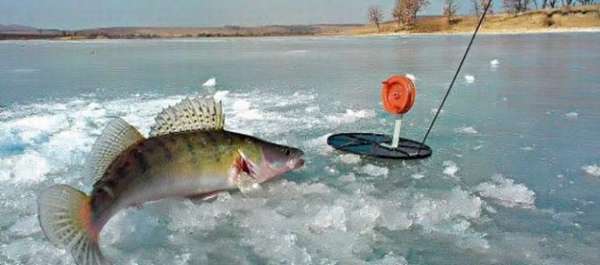
Winter donks
Donka is convenient to use as a tackle for catching pike perch in the winter on the current. To do this, you can use a regular fishing rod for trolling, only in this case the nod is set to a rough one, capable of maintaining a working position in a powerful stream. The equipment used is different, with one or several hooks. But a heavy sinker is attached to the end of the main line, and the hooks are attached to the retractable leashes above. The bait used is sprat, sprat (frozen, unsalted), sliced fresh fish, and squid. The leash with the hook and bait is pulled downstream and makes movements that are attractive to the predator. The fanged one has a well-developed sense of smell, but it has only an auxiliary function. When hunting, the striped predator mainly uses the lateral line, so the movements and vibrations of the bait in the water are important.

On large rivers with strong currents, a pull (pull) is used. This is a standard ice fishing rod for pike perch (or rather donk) with a spring nod, but the equipment is made differently. Higher on the fishing line above the sinker, a long piece of fluorocarbon 0.3-0.4 mm, 5-6 meters, is tied, and leashes with hooks and baits are already attached to it. Such a long tail of the tackle oscillates in a strong current and horizontally left and right, attracting a predator from afar.
Posting bait for pike perch
When catching pike perch using a spinning rod while casting, it is necessary to take into account that in holes it usually stands 50-100 cm from the bottom or at the edge level. Therefore, when fishing with a jig bait, the wiring must be such that it does not drag along the bottom when reeling in the reel, but rises up and falls to the bottom again with a pause, then again reeling in 2-3 turns of the reel.
For such bottom bait placement, there is an original way of catching fanged and various other predatory fish, called a drop shot. In this rig, the bait is on the main line at a distance of 50-100 cm from the bottom, and the load is dragged along the bottom, retrieving in the form of a leisurely twitch. There is also a variant of gear with a retractable leash, where the bait is attached to the main line on a leash made of fishing line above the sinker, the length of the leash can be different 20-150 cm. Thus, the bait passes in the layer above the bottom, where the predator may be located, provoking him to bite.
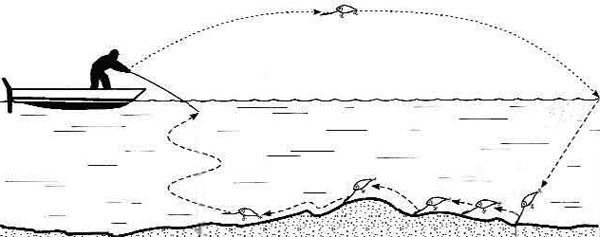
When catching pike perch with a wobbler using a spinning rod while casting, the wobbler must also be held at the bottom in the hole or at the very edge at the exit from the hole. Since the wobbler, due to its parameters, will play itself, the wiring should be leisurely, simply working with the reel, winding the fishing line. And to make the bait look like a wounded fish, you can add movements with the rod, short hooks with the tip of the spinning rod at the surface of the water, periodically reeling in the fishing line. But you definitely need to try different retrieve speeds, since the fish may not react to a bait quietly swimming past it and the bait itself may not attract it. Therefore, it is always better to try different wobblers, spinners and different bait placements.
On the jig
Catching pike perch using a jig is widespread. True, it is unlikely that you will be able to pull out a trophy specimen with such a fishing rod. A large predator often stands alone under a snag, waiting in ambush for fairly large prey - a fish weighing 200-300 grams. It is simply not profitable for him to waste energy on hunting for small things. However, pike perch jigs work great for medium and small predators. The jig for pike perch is large, heavy, with a high-quality sharp hook. It is somewhat reminiscent of a burbot snitch. The same sprat, a strip of fish or, for example, an elastic band from a balloon is placed on the hook of the tackle.
Small pike perch are often taken on the devil or the bald when fishing for perch at depth. The equipment for pike-perch jigs is the same as for trolling - the weight of the baits is comparable, the playing technique is similar. For a fishing rod with a jig (jig head) in a strong current, a technique that works well for pike perch is available - moving the bait along the bottom using the traction force of the water. This way, you can fish a larger area from each hole, making it easier to find points.
Bottom fishing technique
The donk fishing technique is quite simple:
- The first step is to mix the bait mixture. It is necessary to combine components of plant origin (porridge and food for predators) with finely chopped ingredients of animal origin (worms, maggots, bloodworms).
- Add a small portion of crab or meat flavoring to the bait mixture. Let it brew for 20-30 minutes.
- In the meantime, we measure the depth in the window of the reservoir selected for fishing. For convenience, you can use a special marker-type float. If it is not available, you can use stepped wiring.
- Let's start with the initial feeding. It can be done using bottom tackle with a feeder. Cast to the chosen point for fishing and make 6-12 deliveries of the bait mixture. To do this, fill the feeder with the mixture to a medium density and throw it in. When the feeder reaches the bottom surface, you should make a fairly sharp hook. This will allow the bait to fall out.
After this, you can proceed directly to the fishing process:
- Having filled the feeder as tightly as possible, you should place hooks with a sharp sting in it and bait with live bait.
- We cast as far as possible.
- For convenience, we install the tackle on a special stand. If you don’t find one, you can use an ordinary slingshot.
- We stretch the fishing line and connect the bite alarm.
- Connect the friction brake.
- We wait for bites for 15-20 minutes and re-throw the gear. If for several hours there is not a single hint of a bite, it is better to change the casting location or try a different composition of the bait mixture.
- The hooking is carried out quickly and quite sharply. Having hard lips, pike perch have a hard time tearing them with a sharp hook, so the number of attacks by the predator is minimal.
For sprat
In the Volga basin, pike perch are often caught using sprat. This fish is the main food source for fanged fish in the Volga basin. Live sprat can be used as live bait on the bottom, but more often frozen fish from the store are used for hooking onto a spoon, jig or hook. This is convenient for the townspeople of the Volga region - I bought frozen sprat in a department store - and there is no need to fool myself with searching for live bait or other bait. Yes, and the striped one on the Volga takes well on sprat. Most often, the sprat is planted on the hook of a diverter leash, a jig head, a jig or a special tackle. There's a lot going on here. You can also fish for pike perch in winter for fry in other regions, using fish species found in the reservoirs of those places. It doesn’t hurt to check the sprat, even if it’s not found there. You can also try frozen capelin or sprat.
How to choose the right gear
For high-quality assembly of equipment, it is important to correctly select the elements for it. Below are recommendations for each part.
Hooks
The optimal hook for fishing with a retractable leash is a single one. If fishing takes place on reservoirs with a clean and relatively flat bottom, standard singles and doubles are suitable. Where the bottom is full of snags and underwater vegetation, an offset type of hook is used. The bait is attached to them in a non-clinging way. The size of the hook is selected in accordance with the size of the bait.
Cargo
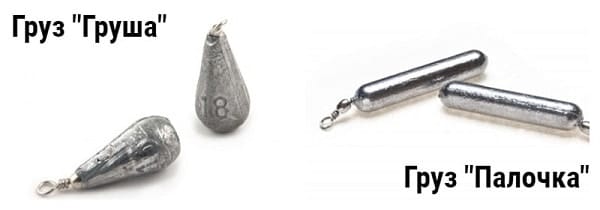
It is taken in a streamlined shape for free movement through various obstacles. Popular shapes:
- pear
- wand
When purchasing a sinker in the form of a long stick, experienced fishermen bend it, giving it the shape of a banana. This increases cross-country ability and improves the quality of wiring in reservoirs with a steep bottom.
HEALTHY! Special ballerina sinkers have gained great popularity. They are attached directly to the fastener, making fishing line for creating a cargo leash unnecessary. In this case, the bait moves as close as possible to the bottom.
Leash
Consists of 2 elements:
- Cargo leash. The length ranges from 20 to 50 cm. But if fishing conditions require it, then it can be increased or decreased. Material: monofilament line. The breaking load of the cargo leash and cord must be at the same level.
- Leash with bait. The length reaches up to 1.5 m. The thickness depends on the size of the fish being hunted. Material: fluorocarbon. It is invisible under water and wear-resistant. Does not stretch, which ensures sensitive wiring. It is allowed to use monofilament fishing line as the material. It costs less, but the efficiency is much lower.
If the bite is bad, avid fishermen advise increasing the length of the leash with bait.
Coil
The generally accepted coil size is 2000-4000. The exact indicator depends on the fishing conditions. The reel clutch must work with high precision. And the reel itself has a smooth run, winding the thread (cord) evenly onto the spool.
Rod
Considering that the leash with bait can reach a length of up to 1.5 m, the rod is taken quite long. When selecting a rod for fishing from the shore, it is important to evaluate the range and the absence of obstacles when casting. Standard length is from 2.7 to 3 m or more. When fishing is done from a boat, they often take spinning rods 2.4–2.7 m long. The recommended action is fast, medium-fast. The test is selected individually depending on the weight of the sinker and the size of the future trophy.



